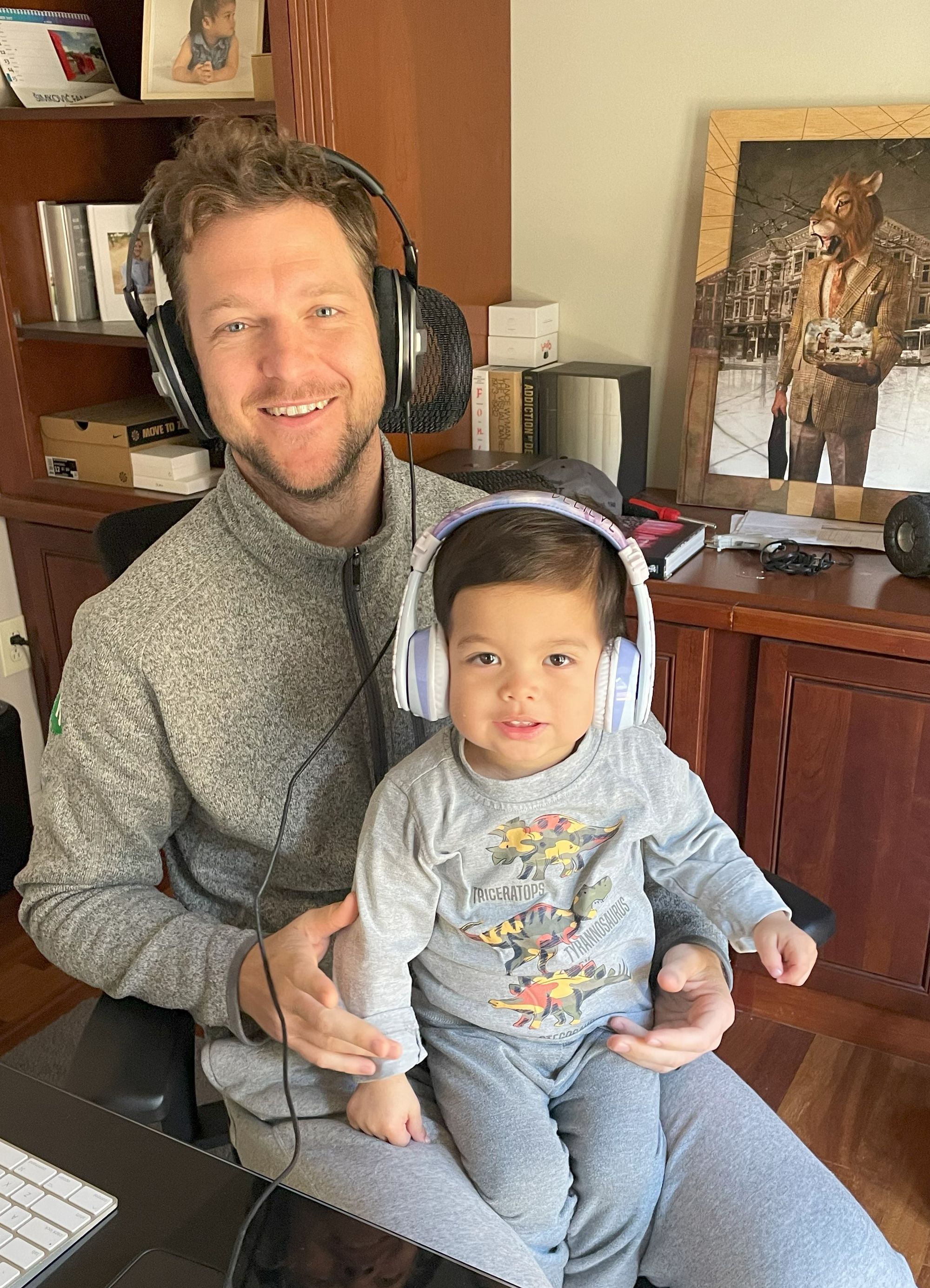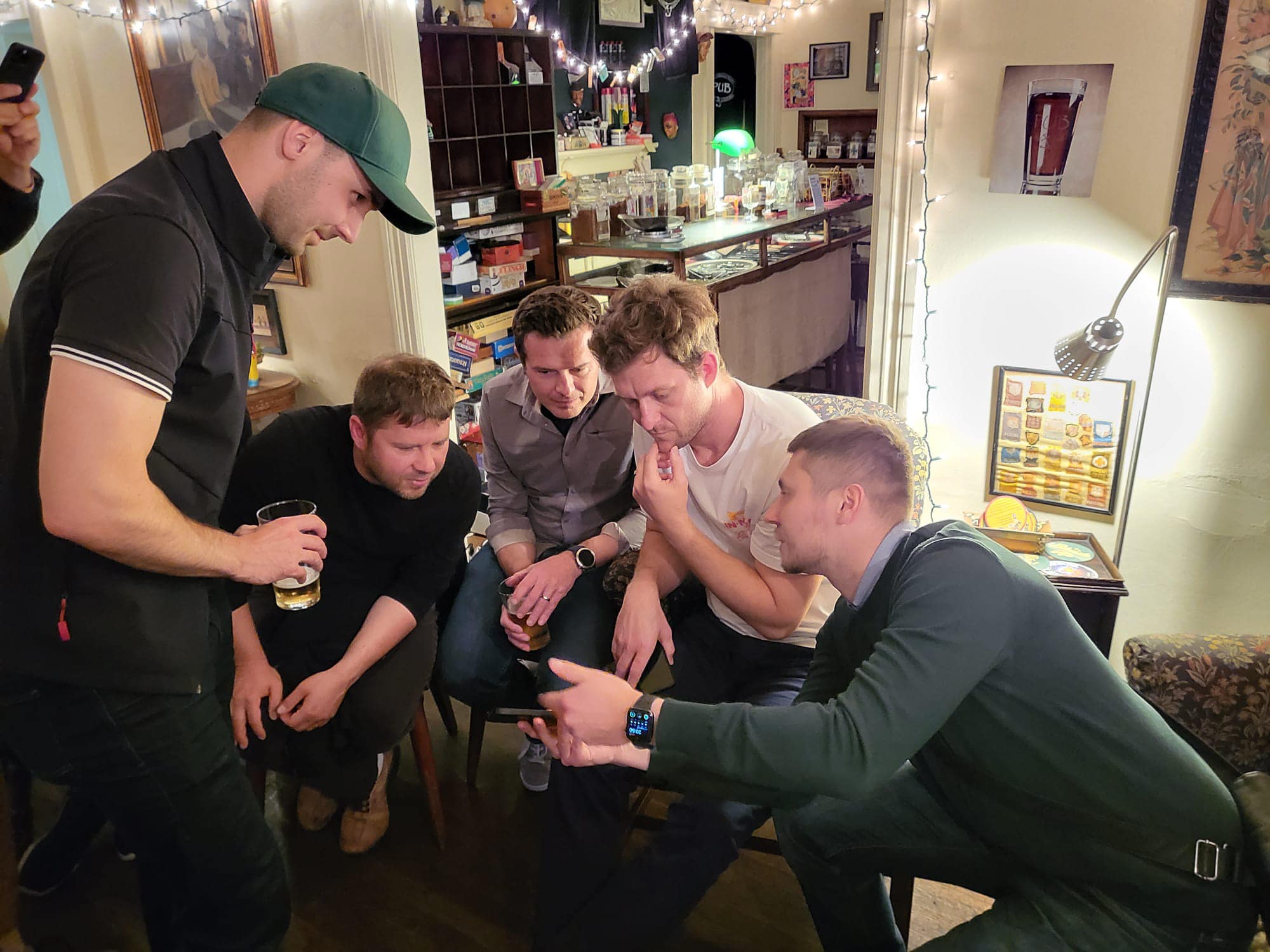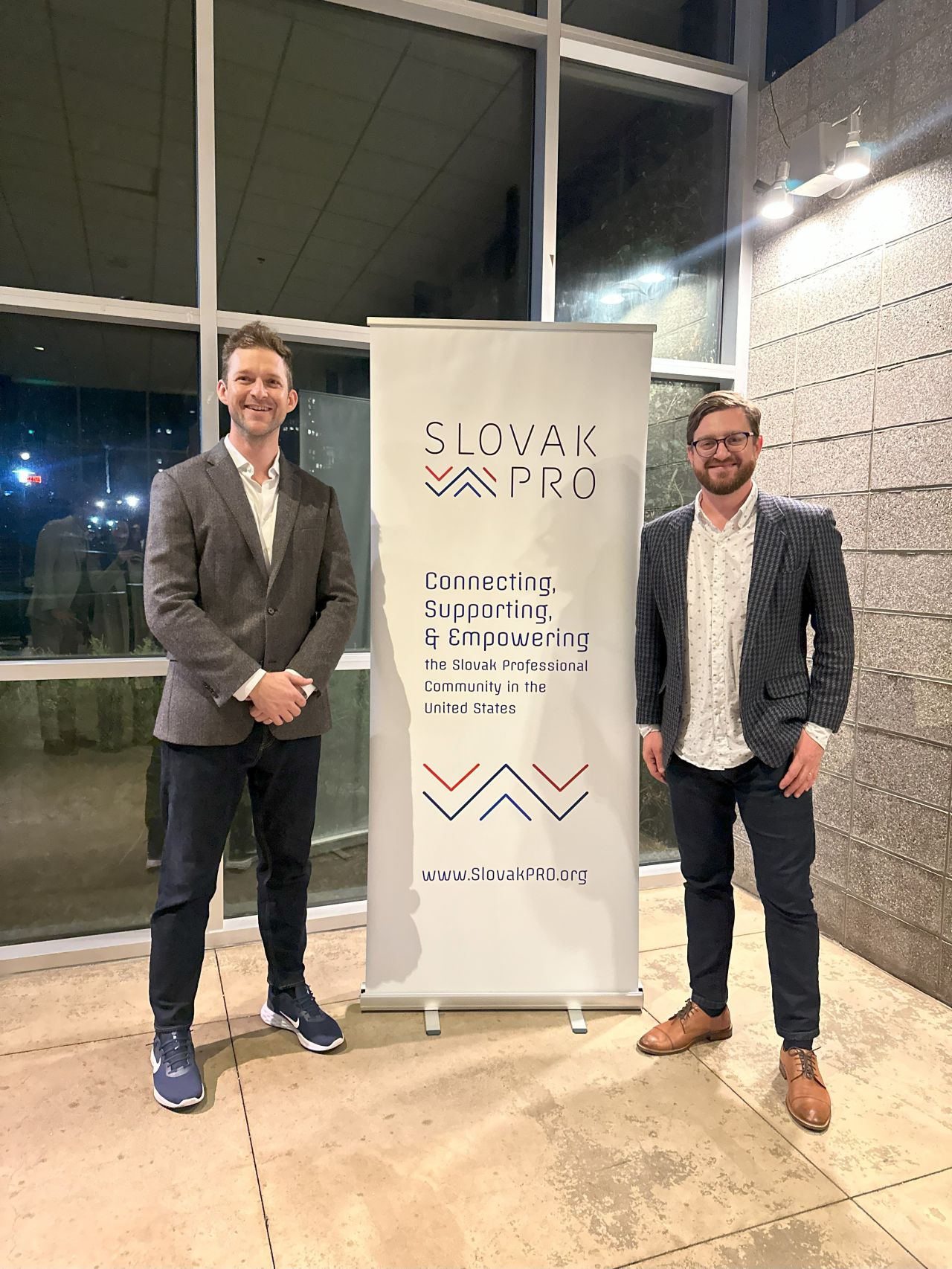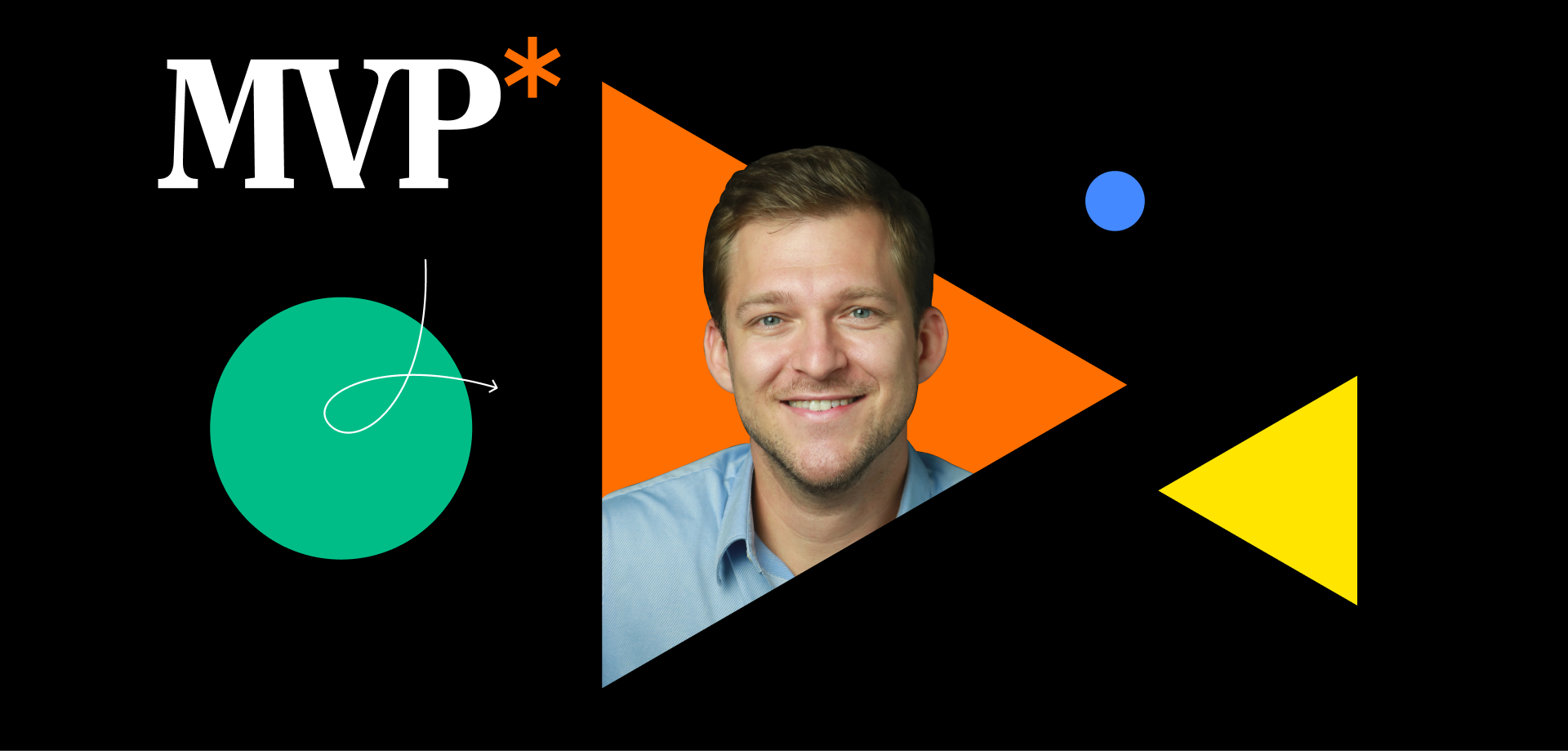Michal Šimkovič alias Musho is a seasoned designer with a rich track-record that ranges from visual design and branding, through building and leading teams, to launching startups, investing and strategic consulting.
In the 24th episode of Minimum Viable Podcast, Michal Blažej discusses with Musho how has design changed since his beginnings, what was the diversity of jobs he has experienced, what’s his approach to different types of assignments, what are his sources of inspiration or what does he think about the future of design with the advent of AI.
Minimum Viable Podcast is brought to you by the CX design studio Lighting Beetle*. It's usually recorded in the Slovak language, however, you can read an English transcription of this episode below. For more English content, including case studies and handouts, visit our Journal.
What was the biggest change you've experienced in those 15 years?
A lot of things. The iPhone came along. We were still working in the pre-iPhone era, which kids today may not even remember. Then various Alexas without any visual UI came. Now Neuralink might be coming. AI emerged. Everything started moving to the cloud. The tablet as a form factor emerged. Many quite interesting new things have emerged, and I think more will come.
What kind of designer are you? What do you design?
Everything. Maybe it's also lucky that I've never drawn a box around my responsibilities, saying, 'This is my job, and from here on, you have to find someone else.' So, I do everything that needs to be done. Currently, I'm cleaning sales decks and setting up emails for conversion. There's no such thing as a small task.
Do you feel stronger in some areas than in others?
My role is to help the CEO take care of design. Build the team, brand, etc. I was joking a bit with those emails, but I do everything. Mainly the strategy, what we'll do, how it will look, how it will behave, how it will communicate. All of this is part of the design.
When I started, we were clicking. It was maybe a hundred projects a year. We had one or two clients at work. I would come home to the dorm in the evening, and I'd still have another client as a freelancer. That was tough, and maybe that's changed over the past 20 years. If I started with 100 projects a year, now I do one or two projects a year. But grinding and clicking at the beginning was very good. It gives you speed, you learn a lot, and I would recommend it to every youngster.
I remember when you were in Zaraguza, you were able to click out a website in a few hours and give it your touch. You mentioned now you get a task from the CEO to take care of design. What is this task usually like for you, or what are the expectations?
It depends on the job. For example, at Around, we had a 'keep it small' approach. Keep the team as small as possible, we need to find that product-market fit, we need to stay agile, and small. In another case, for example, it was 'make us enterprise-ready.' As they say, 'button up, put on the shirt, make it look serious.'
"My task is to build a team, brand, strategy, what we'll do, how it will look, how it will behave, how it will communicate. All of this is part of design."
So, CEOs have various tasks. For example, the task at Circle was that no one's using it, so redesign something nobody has ever seen before, so at least they'll come and look at it for a while, and maybe more people will come by then. So, the tasks vary.
When you mentioned Circle, that you had to motivate people to be interested in the product, how do you approach such a challenge?
It's great that when you have to come up with something that no one has thought of yet or drawn, you can get inspired and draw things from completely different places. For example, we had this weird circular interface, and kids would call me and say, you're the one with the circles. Usually, you take things from other disciplines, get inspired, and bring them in. That could be a pretty good tip.
You talked about the visual side, but how do you reach potential customers with some interesting ideas? Is ideation also part of your job, or is it mostly done by someone else?
I'm usually in a supporting role in ideation. In Zaraguza, Mišo was the main ideator. So, I always helped people with ideas like this. For example, quickly visualize something, so they can prepare it as soon as possible, quickly explore, cover as much space as possible, so we can see what's possible.
When you talked about buttoning up and making it enterprise-ready, you were probably talking about HackerRank, right? Can you tell us what kind of job it was and what kind of product it is?
HackerRank is a product for companies that are looking for developers. Instead of talking to them on the phone or looking at some keywords on a CV, they send them a task, and HackerRank can precisely evaluate their coding skills. Before that, I was in a corporate environment, where a lot of things bothered me, and then my friend from HackerRank told me that if it's bothering you there, come to us. Here, you can build everything yourself, and the only one you'll be able to blame will be yourself. That was quite a good deal, so I went there. He always had problems with designers. They would quit, and those positions weren't sustainable.

I started alone, so I did what they needed first. I did some presentations for sales, etc. I hired a great designer for the brand. Then we had a team in India, which was still a mess because we couldn't hire a lead designer there. They thought I was in the States, in Silicon Valley, and they would only work there. So, I packed and flew to India. After half an hour, I already had a lot of interviews, and we immediately hired people and grew the whole team, until there were about 8 people in the end.
How did you know how to approach it? How did you set the expectations for that hiring? How do you approach such completely different challenges?
As Jobs said, managers should be those who were very good individual contributors. During an interview, I already know about 80% of whether I hire someone or not. You see the attention to detail in their portfolio. Then I just check if that person is not incompatible with the rest of the team. When you do it yourself, you know how it works, and what it requires from a person.
Around was a big thing; we all used it until recently and were very excited about it. Can you tell us the story around it? How did you get there, and what was your mission?
At first, I was just helping out when they needed something to draw or help with the brand, visualize something. Later, things started to pick up, and we found something useful for users there, so there was room for full-time. So, we played around with it, tried various things, but real-time media is a very tough business. Doing things under 100-150 milliseconds is not fun. Many companies were created there. Thanks to that, web artists could jump-start, they could do 80% of the product immediately, but then the remaining 20% was difficult. Doing it for all platforms, considering all those new operating systems, browsers, devices, headphones, which behave completely differently, that are coming out. So, it's not fun.
What was the feedback process like? Wasn't it limiting? If something didn't work, did you have to come up with something else? Can you remember something you had to take into account?
We for example had a rule that we couldn't put anything in the lower right corner, because as you stretch it, it would jump. You could see how the web was being rendered, and people would realize it wasn't native. So, we faked it in various ways. We also used Mac components to make it look native so that users would be satisfied.
It seems that many things happened to you by just sort of helping somewhere. How do you find time for this helping alongside, which sometimes, like in this case, eventually became a full-time job?
At first, it wasn't serious. Maybe I wasn't even the best designer; I was just there for them. When it comes to time, I've never had a problem. You have to have good time management, and everything is possible. You have to figure out where you can bring the most value in a few hours.
How do you decide what to invest your time in and what not?
I don't have any preconceived rules. When I don't know what to do, I go out with children to the park, because I know that's a priority, and there's never enough time invested. I also cancel meetings to which I don't add that much value. When they really don't need me, it's enough if they send me what they agreed on.
"It's crucial not to fall in love with your ideas. You have to be able to kill your darlings anytime"
When you're doing a visual job, do you timebox your work, or do you go until you feel it's good?
It depends on whether something bears fruit or not. Usually, I'll load the problem into my head, and the UI or UX will come together in front of me, and then I always assess if it’s done, and if not, I give it another day. Sometimes you have it in half an hour when you're in the mood for ideas. Sometimes you struggle. I don't timebox it at all.
With many visual designers, I see a pattern that they work on projects until they're perfect. But then the client often can't appreciate it. They appreciate that it's delivered on time.
Usually, I do 80% and three versions. I quickly show them and name that everything has its pros and cons, there's no perfect thing there. This way, I try to be a partner also in decision-making. Another thing is not to get married to your idea. You have to be able to kill your baby, as they say.
How do you proceed when you get a task? What do you have to go through from the first point? Do you have a tidy workflow?
The most important thing is to have a talented team. But I do mood boarding. I try to look at more things. Twitter has worked very well for the last six months. Everyone moved there from Dribbble. There's a lot of great design inspiration there.
And then that profaned design thinking. But usually, it works like this: diverge and converge, repeat it a few times, and come up with something. And then as soon as possible, involve the partner you're working with in it. Then they feel that it was also their idea; you communicate that to them and get them on board. Then towards the end, when you've hit it, make the final high-fidelity things.

You were really able to excite people with visuals in the first place. You showed them something very nice, and they really wanted it. But isn't this just A, and then the implementation and reality look different?
Nowadays, technologies are so advanced that what we sell is quite close to reality. I usually try to have some background idea there, even if it won't be immediately readable from the design. Like how FedEx has that arrow. Something you can say, and then it's easier to sell.
Can you give an example?
Last time I worked on a brand update, I made it look broad and expanded, and I told them that it's exactly like Formula 1, that it shows speed, and they really liked it. That's the storytelling.
How do you manage to react to all the changing needs and stay relevant?
When you have it as a job, people are afraid of losing relevance, but when you also have it as a hobby, it goes hand in hand. And for me, it's questionable what's relevant and what's not.
In my opinion, the visual style is constantly evolving. Interfaces are changing. Knowing this and knowing how to react to it seems to me that as a designer, you need to have a lot of awareness and study a lot, which requires a lot of energy. Do you do this actively, or does it just stick to you?
Are you giving me a hidden compliment now?
I am!
I think such mental flexibility is important. That's something I look at when I hire too. I look at the very first things on a portfolio, and then I compare them to the current ones, and I see if the person stays the same or is flexible and agile.
What was your experience like at Amazon? You came there directly from the startup environment. How was it different?
I have to say, I was lured there by a friend who was spraying on wagons and doing tattoos. He was my boss at Amazon. It was a great experience. There, you need a different design muscle to exercise. You have to be able to communicate with the team around you, and build relationships. It's a bit like diplomacy. Maybe the visual output and the UX weren't as strong, but it was more important how to implement it into production.
It was probably quite a data-driven design there. Did you also do user testing and such things?
We did, but it was so corporate that we originally paid fifteen thousand dollars for one study because there were terrible bureaucratic obstacles around it. So then I came up with the idea to start doing user testing for 99 dollars. When I showed them that, they asked, 'What kind of magic is this?' But at first, they disagreed because things could leak. So, I agreed with the legal department that if we debrand it and make it a completely anonymous study and only ask about UX, we can do it. So we reduced it from 15,000 to 99 dollars per study.
Jumping back to those startup jobs. Do you do any user testing there, or do you go lean startup, deploy and see?
No, we tested a lot. At the beginning, we did the white glove onboarding, where everyone who registered got 30 minutes with us. So, we would sit there and listen to their initial reactions. That was very good.
"I usually do 80% and three versions. I'll explain which one leads us where. This way, I try to be a partner also in decision-making."
You're simultaneously an investor and an advisor. How did you get into this role?
Accidentally again. I became an investor because a friend who was sleeping on our couch had an interview with the same investors we had, and I told him that sometimes it takes 3 or 6 months for the money to come from them. So, I gave him a check just in case and became an investor. Then, when I had some money, I thought I couldn't just throw it around here, hoping for the best. From a certain point on, it won't be just about luck anymore, but you can start looking to see if you're catching any trends.
A visual designer became someone who supports startups. What's your approach now? Do you advise someone? What are all the things you're currently considering?
I try not to advise. We have a non-profit where, as part of Slovak Pro, we run a Brain Board program where we have a bunch of Slovaks from abroad, and I try to connect them with relevant people. It's not just about design. There are talented people from business, great investors who are Slovaks and want to help Slovak companies. So, I'm more of a switchman. It's quite an interesting network. We've seen it work well in other countries, so we said, why couldn't we have it too?
How do you present yourself to the world? What sells you as a person?
You have an online footprint, so now I don't have to go looking for jobs. Offers come to me. The track record is probably the best thing that can sell me.
What's the mix of people who approach you?
We've stopped doing visual jobs. At one point, when someone wanted something, I would say okay, but it would cost 150,000 for some nonsense. And they agreed. So, we said we probably should have asked for more. I try not to do small things anymore. I'm working on bigger, more strategic things.
What are the types of strategic things that would interest you now?
AI was important to me. It annoyed me that something new came out every day, and I didn't have time to follow it, and I was lazy. So, I said I need a job in this industry and I need to go learn it, so now I have no choice and I have to follow it.
That leads us to your current job, which is Copy.ai. Tell us what it is and what you'll be doing there?
They were the first client of Open AI. They became model agnostic, which means all the models are there. You don't have to pay separate subscriptions for each model, but you have it all in one tool and you just choose from the dropdown whether you want Chat GPT, Claude, or whatever you need. It works like this: some people come up with the models, and then there are imaginative people like us who apply them and make money from it.
Who is this tool intended for?
The vertical is for sales and marketing.
So, if I wanted to sell my services to someone, it would prepare texts for my cold sales?
Exactly. Either for cold sales or for inbound or outbound. I don't want to sell it to you too much, but I'll just tell you how it works for us. In cold sales, there's generally a role called SDR, which are the ones who plan and do everything, but we don't have that at all.
When someone registers on our website, it goes through that AI, and it pops up in our Slack, saying that this person has arrived with an estimated deal value. Our salespeople each have their emoji and they just press their emoji, and that AI takes this registered person based on their email, finds their company, finds out what this person wrote about the company in 6 months on the internet, then finds out what the company's goals are, and it gives you all that back into Salesforce.
So, everything that happens is that the salesperson just comes to the meeting and says, listen, I'll tell you the story of how you got to this meeting. I pressed one emoji in Slack, and continues by showing them the whole process, what the AI has found exactly for them, what they should sell them and why. So, this AI is very well applicable to this. And will people survive without such an approach? Of course, they will, but those who will use this will make leaps and bounds.
You just sold it to me. Does it also work with Slovak?
Sure, it's text-based, so it's already at a very good level with text. And for marketing and SEO, they have a lot of hits on traffic thanks to that. Being a business or a startup, I would already look around something like this.

That sounds very interesting. So you managed to get a job in AI as you wanted, to stay relevant? What will you be doing there? What is your role?
My role will be to build a team and build a brand. The name Copy.ai is still from the old days when they originally only did copywriting and marketing stuff, so we'll probably have to go through a rebrand. A big problem with the product, that it's a completely new area. People don't know how to use it at all, and from what I've seen from those calls with customers so far, people go into the product with a very bad emotion, they have a huge fear of two things.
One is that this is some kind of future and they think they won't even be able to control it. The second fear is that Am I going into that tool that will take my job soon? Is this what will make me irrelevant? The main question I'm dealing with now is that we're selling the future, so should we look like the future? Should I make the coolest sci-fi interface that will be like the Avengers or should it be the most boring thing that people are familiar with? So these are the main questions that I will have to solve now.
So now you're trying to understand what are the customer's views, so are you going on sales interviews?
Yes, even though our sales calls aren't even sales calls. Most of those people are like, give it to me, set it up for me, and our guys are slowing them down a bit.
How do you perceive the future of design through this AI? What should we designers prepare for, what will happen?
I don't know if preparing is a good point. Designers should play with it, try things, look for different improvements and such. In my opinion, the future will be that we won't have to click anymore. It will come from Neuralink straight from the brain, and you'll already have it built, so there won't even be an intermediate stage of the design interface. Hard skills won't be as important anymore. It'll be more about your taste.
"In the future, I think hard skills won't be that important. It'll be more about your taste."
With all the design systems, assembling it with AI will be the least problem, but a person will be needed again in problem-solving and thinking, which you also have in front of you now.
Probably, but I think that AI will still lag behind. There are a lot of promises, but it's not there yet. I even saw an ad, where there was a cowboy with too many fingers, which only AI can draw, and they made a joke there, that: “ask more from your AI.” So maybe we still have such a wave of sobering up ahead of us, until it catches up, and it may take a few more years until it starts to be implemented and has some reliability.
You have a good point about taste because those AI-generated things are really tasteless.
Some. But I've also seen some that were great. You have to twist the AI's arm behind its back to draw what you want, but it's starting to be interesting.
It's a huge opportunity. We see it a lot in UX, that we can quickly research things, put together research results, do desk research and all these things that previously took relatively long. And in visual design, we also see that it's pushing into Figma in a big way.
I'm still a little afraid of those rights. The training data they used. I hope we can come up with a concept to support those artists too. That will be another challenge.
Musho, I have one last question for you, which I ask every guest. What is the biggest design challenge that you would like to solve?
I don't know if it's a challenge, but I made a resolution that I want to keep a small design team. There are already so many tools, and those people can 10x themselves. We tried it at Around because we needed a very small team, but I'm thinking that even with growth, how not to turn it into a corporation. How to build an ideal team where there will be fewer quality people, each with something, and they will also have that AI behind them, maybe even an agency.
Musho, thank you very much, you gave us super interesting insights into how a visual designer, who clicks a lot, became a visual designer who clicks less and now uses all his experience in practice.
Thank you very much, Mišo, and take care. Good luck to everyone!
The full interview with Michal Šimkovič in Slovak:
Minimum Viable Podcast is brought to you every two months by the design studio Lighting Beetle*, which focuses on creating an exceptional customer experience.
Design is all around us. Minimum Viable Podcast explores design with a small “d” – the one that looks for solutions to people's problems. In it, together with our guests, we address topics that are related to design, but we normally do not associate with it. Thanks to the Zeldeo production studio and our production manager Mojmír Procházka for the cooperation.
We are looking forward to every listen, follow, share, and suggestion for improvement. You can send us your tips for interesting personalities with whom we can talk about design to podcast@lbstudio.sk.
Enjoy!



